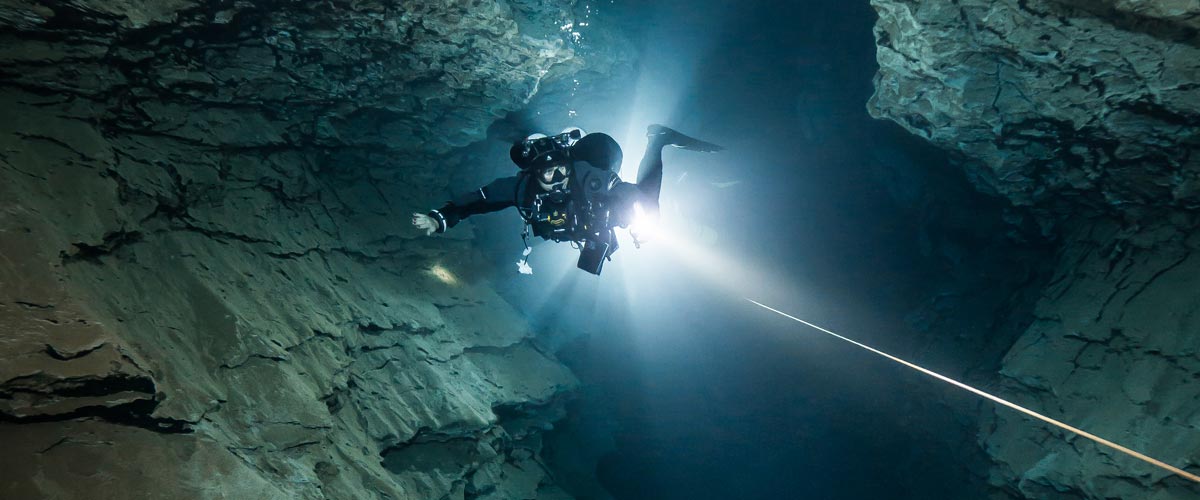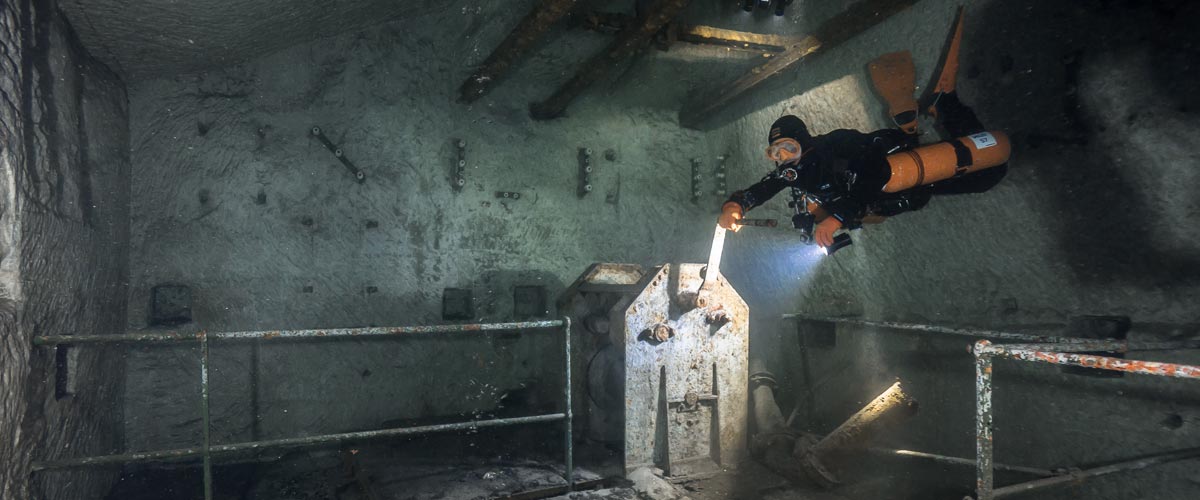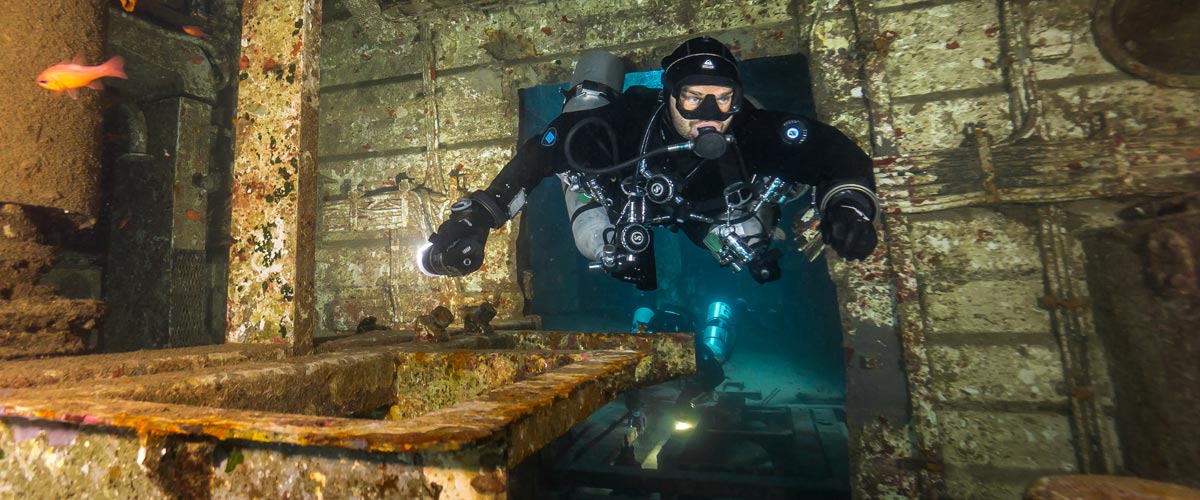Dive Training Blogs
Oxygen Toxicity
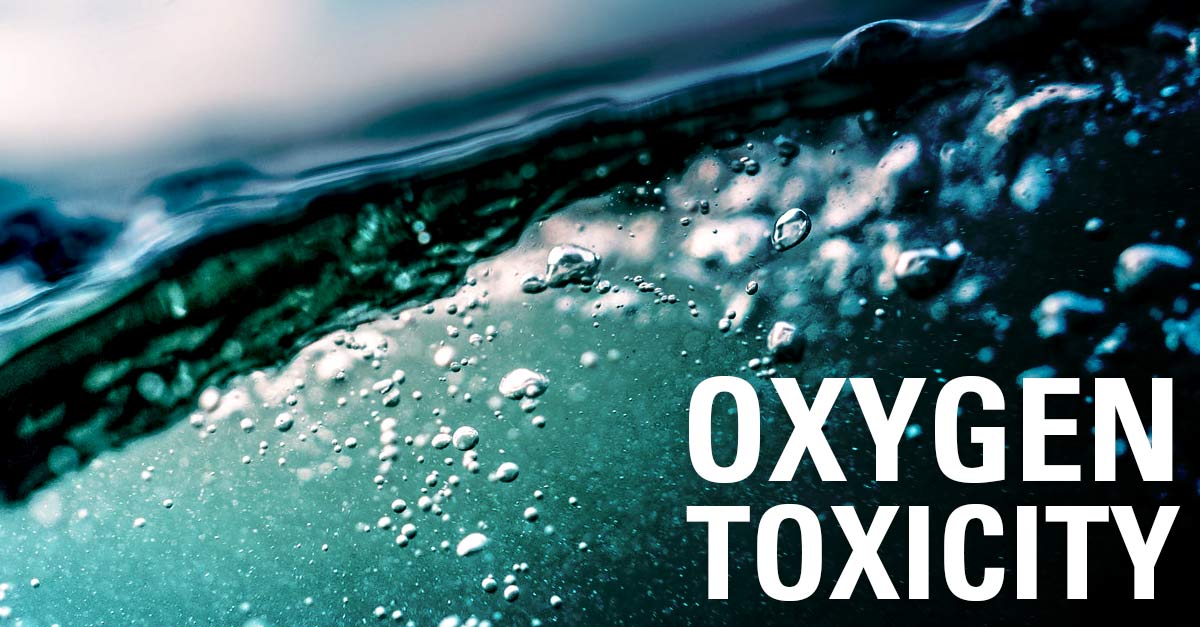
By: Gemma Smith
The existence, development, and continuing survival of human life is nothing short of incredible. This is especially true when we consider how many different factors had to come together to make life here on earth possible. There is no more obvious example of this ideal melding of variables than in the air around us. We all remember our basic science from school. Here we learnt the air around us is about 21% oxygen and 79% nitrogen (give or take the odd trace gasses). As far as our human body is concerned, we can take or leave the gas nitrogen. On the other hand, oxygen is absolutely critical to our survival.
Without this tasteless, odourless, colourless gas, we simply wouldn’t be here. We all know that too little oxygen (hypoxia) is a BAD thing. Less commonly known is the fact that too much oxygen (hyperoxia) is equally bad. Yes, in excess, oxygen is, in fact, toxic to us. Now, this wouldn’t be so much of an issue if we kept our feet firmly on terra firma…but we are divers. We journey into a new dimension, with new rules, and therefore new risks.
Partial Pressure
In your initial scuba diving class, you will have learnt about Dalton’s Law. This Law states that the total pressure exerted by a gas mixture is equal to the sum of the partial pressures of the different gases in the mix. So, at the surface, the partial pressure of oxygen is 0.21 (21% oxygen breathed at 1-atmosphere pressure). This changes when we dive. The increasing depth when we submerge causes an increase in the pressure around us. This means an increase in partial pressure as well. The partial pressure of the oxygen in our breathing gas will of course rise. This can potentially cause all kinds of issues.
These issues are especially pertinent for divers today. There has been an increase in the use of Enriched Air Nitrox (a gas mixture with a higher than 21% oxygen content). Deep diving beyond recreational limits (most often set at depth of 40m/130ft) is now commonplace. This type of diving requires the carrying of various gas mixtures. Some of these gasses will have a higher than normal oxygen content in certain designated cylinders. This is to aid and accelerate any decompression that may be incurred while at depth. Finally, the growing use and popularity of Closed Circuit Rebreathers also has implications. Many of these units utilise pure oxygen as one of the onboard gasses. This means that more than ever we need to be aware of our oxygen levels. Alongside the dangers of insufficient oxygen, it is equally important that we can spot potentially fatal problems that can occur because of too MUCH oxygen.
Types of Oxygen Toxicity
Very broadly speaking, oxygen toxicity splits into two main types. These are Central Nervous System Oxygen Toxicity (CNS), and Pulmonary Oxygen Toxicity. In all but the most extreme dives, the most common issue for divers will stem from CNS toxicity. This usually happens by breathing a gas mixture at the wrong depth. The partial pressure of oxygen (PO2) in the mix should never exceed 1.6 ATA (Atmospheres Absolute). To put this in context, breathing pure oxygen should not happen deeper than 6m/20 ft to ensure the PO2 does not exceed 1.6. Ideally, unless decompression is happening, your PO2 should be at no higher than 1.4. Pulmonary Toxicity, on the other hand, comes from breathing an elevated partial pressure of oxygen over an extended period of time. Oxygen toxicity is a fascinating and important subject. It is worth noting though that it is still not fully understood on all levels. Prevention, as in most things, is better than cure.
Let’s look a bit closer at the signs and symptoms of each of the main types of oxygen toxicity:
Central Nervous System Toxicity
The chance of problems with CNS toxicity is most likely in the kind of diving many sport divers do. These dives are typically short durations at depth, but potentially much higher than normal PO2 exposures. As we have already said, CNS toxicity tends to happen when breathing a gas mix that exceeds a PO2 of 1.6. Dipping below the maximum operating depth for what you are breathing, or breathing the wrong gas, are easy ways to exceed your PO2 limits. To help you remember the key things to look for both in yourself and others, remember the acronym CON-VENTID.
- CON – Convulsions. These convulsions in and of themselves are not lethal. Convulsions underwater increase the likelihood of you losing your regulator. This can be fatal.
- V – Visual disturbances. This can range from tunnel vision to blurring.
- E – Ears. A ringing in the ears or other auditory disturbances.
- N – Nausea. Intermittent or constant, with varying severity.
- T – Twitching. Most commonly noted in the facial muscles, although not always easy to see when wearing a hood and mask.
- I – Irritability. Any kind of character change.
- D – Dizziness. Feeling confused, or a sense of vertigo.
Of course, the first thing to point out is that many of these signs and symptoms overlap with other common diving problems. Nitrogen Narcosis can produce many of the same effects.
Knowing all the possible signs and symptoms to look out for is nonetheless important. It is worth noting though that for many CNS toxicity cases there may be no warning. Convulsions will be the initial, and clearly blatant, indication that something is seriously wrong.
Pulmonary Oxygen Toxicity
Pulmonary toxicity tends to occur in only the most serious of technical dives. Extreme depth or duration can mean breathing an elevated PO2 for many hours. The partial pressure is usually not high enough to cause immediate CNS issues. However, over a significant time period irritation of the lungs may occur. This can cause a burning sensation in the throat, coughing, difficulty breathing or shortness of breath, among other things. Published tables show the maximum amount of time considered safe to stay at a certain PO2. Technical divers planning to do excessive decompression are well advised to implement air breaks. This allows the lungs to have a break from a high PO2 for a period of time. It is also important to consider that Pulmonary oxygen levels do not decrease with a surface interval. This means even recreational divers can be at risk of pulmonary problems when completing multiple dives with nitrox over multiple days.
Preventing Oxygen Toxicity
As with everything related to the human body, nothing is set in stone. Day to day variables will cause your body to react differently to situations. All the limits set in place for avoiding oxygen toxicity are guidelines. It is always prudent to work well within those limits. There is no way to guarantee that oxygen toxicity will not affect you. There are however several steps you can take to minimise your risks:
- Analyse your gas – Never breath anything that you have not personally analysed. Calibrate the analyser, analyse your gas, and then correctly mark that cylinder. This includes writing what percent you analysed, and what the maximum operating depth for that gas is. All divers, without question, must do this for every single cylinder that they take in the water.
- Watch your depth – Even when a diver correctly marks all gasses, if they do not stick to depth limits they are not helping themselves. Most dive computers now have alarms for when you exceed the depth of the gas you have programmed in. Dive computers are also a good way of tracking your oxygen exposure over several dive days. Stay aware, and make sure you maintain good buoyancy control at all times.
- Avoid strenuous activity – Carbon dioxide has been shown to increase the likelihood of oxygen toxicity. Never work hard underwater, or get out of breath. Make sure your regulator is properly serviced to ensure an easy breathe. If you do have to work physically underwater it is worth considering the option of a full face mask. There are many options we as divers can take to limit our risks. It is important that we utilise all that is on offer to keep us safe.
Both types of oxygen toxicity are something all divers need to be aware of. Whether doing shallow or deep dives, recreational or technical, it is important to always know and be aware of what you are breathing, and what depth you are at. It may save your life.
To find out more about International Training, visit www.tdisdi.com.

Blogs
Intro to Tech: What is it about?
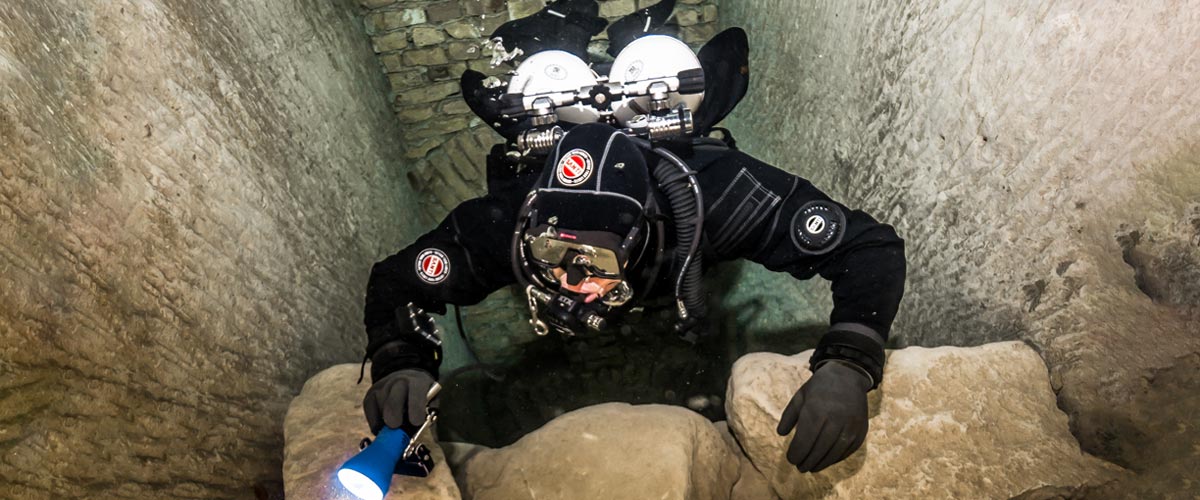
Article by José Pablo Mir
Pictures by Cezary Abramowski
The world of technical diving is exciting. It opens the door to new sites, depths, and bottom times. More importantly, it opens our minds to a new way of planning, facing, and experiencing dives, even those not purely technical.
Becoming a technical diver is a process, and like in other aspects of life, we should find the proper entry point that suits us best based on our knowledge and experience. The Introduction to Technical Diving course from TDI -the world’s largest and most recognized technical diving teaching organization- is the best option for divers who have yet to gain experience in the fundamental aspects of this new practice. The course’s content and its embrace of new techniques and technologies make it possible to acquire a solid foundation to learn and gain experience in this practice properly.
Becoming a technical diver is not something that happens overnight, whether deciding to become one or receiving a certification card stating we are now technical divers. It is a slow process extending farther away than any introductory course. It requires effort and dedication. But it will bring us satisfaction from day one -or two.
It is a matter of mentality
First, we must understand and accept that technical diving, involving greater depths, longer bottom times, exotic gases, virtual or real ceilings, and more, comes with higher levels of risk than the sport diving we have been practicing until now.
Although this discussion usually starts with a warning about risks, as I’ve done in the previous sentence, our practice is not a game of chance.
Technical diving is a rational activity that requires maturity and good judgment, and we will put everything into ensuring that each dive is a successful one -meaning we return from it safe and sound. With this understanding, we will strive to establish a mental attitude more aligned with our practice and its realities.
This new “technical diver” mindset we will develop will lead us to be more cautious in our executions, more analytical in our plans, more rational in our strategies, and more detailed in our procedures.
Experience will keep teaching us to know ourselves better, to keep our anxiety and other emotions under control, and to manage our impulses. Over time, our senses will sharpen, and we will be more attentive to the particulars of the situation we find ourselves in.
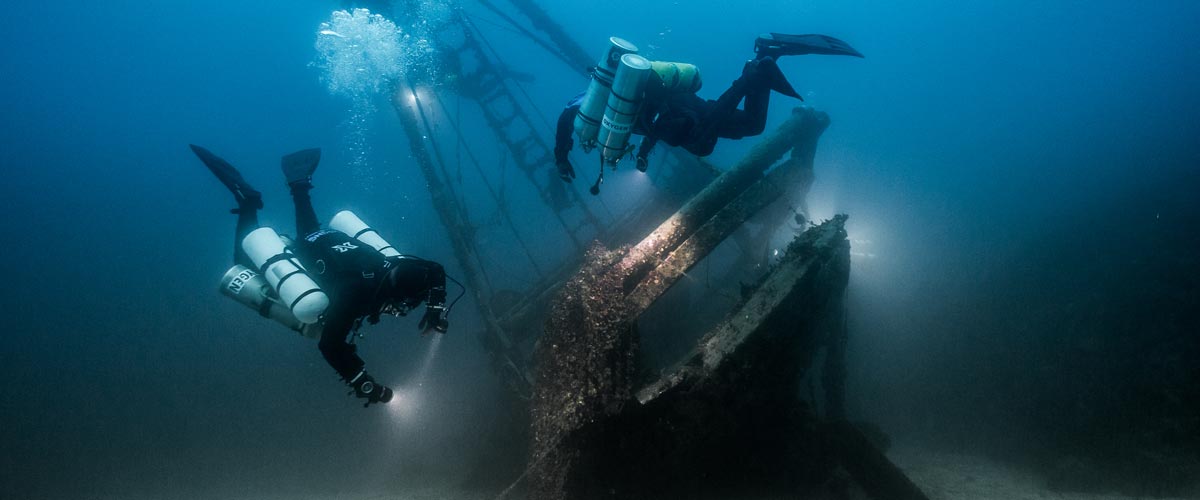
Strategies and procedures
Our strategies, those broad guiding lines tracing the path to follow, from how to approach planning to where, with what, and how we are willing to get there, will be more specific and more practical. Not because they magically become so, but because we will consciously and deliberately frame them that way.
We will establish clear, concise, and realistic procedures. Not only for the undesirable situations that may present themselves but also for those that are part of our dive objectives.
Even though, as technical divers, we often use equipment different from what we were previously accustomed to, it is essential to note that the gear does not make the diver. In a way, we could consider such equipment as the necessary tools to implement what our goal seeks to achieve, according to our strategies and procedures.
Technique plays an important role
We must put our greatest effort into learning and perfecting the different techniques we will be acquiring. Buoyancy, trim, propulsion, cylinder handling, deploying DSMBs and lift bags, valve drills, and more are essential skills we must begin to master to progress in our art. What we cannot do, when we need to do it, can harm us.
Our techniques must be effective and achieve the purpose for which they were devised. But they must also be efficient and require the least resources possible, including the time they take and the effort they demand. Effectiveness and efficiency will prevail over beauty and other considerations that may come to mind, although none of them should be mutually exclusive. A technique executed efficiently and effectively tends to have an inherent beauty.
Refining techniques is a lifelong mission. Some of them will be easy to master from the go; others, on the other hand, will be our life mission and will require many repetitions just to resemble the idea we have in mind of how they should be executed.
We must consider the environment
Our learning, the needs and musts of the practice we engage in, the experience we gradually gain, our strategies and procedures, and even our equipment and tools change with the environment.
Diving in the ocean, everything about us must be suitable for ocean dives. Conditions there rarely emulate those found in a pool, lake, or river. Variable winds and currents, greater depths, visibility conditions, other divers with uncertain skills around us, marine life, maritime traffic, distance from the coast, and many other factors add complexity and uncertainty.
It is never necessary to master the pool on the first day, but planning and aspiring to gradually cope with the ocean’s conditions is essential.
The cost of good training
We are aware that our resources are often scarce in relation to the possibilities of use we could give them if they were not. To a greater or lesser extent, we are part of the economic reality in which we are embedded.
Fortunately, the cost of good technical diver training is not an entry barrier. Comparing training and equipment costs, we see that the former are generally lower. Yes, lower cost for personalized service, essential to our future
performance and safety, than for a series of mass-produced products that are mere, albeit necessary, tools for an end.
The value of good training
The value of the training we received encompasses a range of characteristics, from emotional and methodological to technical and technological. TDI and its Introduction to Technical Diving course offer a deep and modern approach, with a teaching strategy that aims to create thinking divers, not merely obedient ones.
As technical divers, our knowledge is our primary tool. In this type of activity, what we don’t know can harm us.
Is this course optional?
Unfortunately, the fact that this Introduction to Technical Diving course is not a prerequisite for any subsequent training is an invitation to consider it optional. And we all know what usually happens to “optional” under budget constraints.
However, this course should be seen as optional only by those divers who are somehow familiar with the use of technical equipment, who have a mindset more in line with the requirements of this type of diving, who plan and execute the dives the proper “technical” way, who know their gas consumption rate, who are not intimidated by non-decompression tables, who feel comfortable using their dive computers, and know the techniques and have at least an acceptable level of buoyancy, positioning, and propulsion. Those can go straight to a more advanced training course, such as TDI’s Advanced Nitrox.
We must ask ourselves whether or not we are in that group.
Remember our goal: to have fun
Recreational diving is our passion. Jumping into the water carrying heavy equipment and having properly dotted our I’s and crossed our T’s have only one ultimate goal: fun. This is the activity we have chosen as a hobby. We must enjoy it; it must give us pleasure and make us vibrate.
Having a good time is not optional!
Blogs
Four opportunities to go pro in 2024 with Dive Friends Bonaire
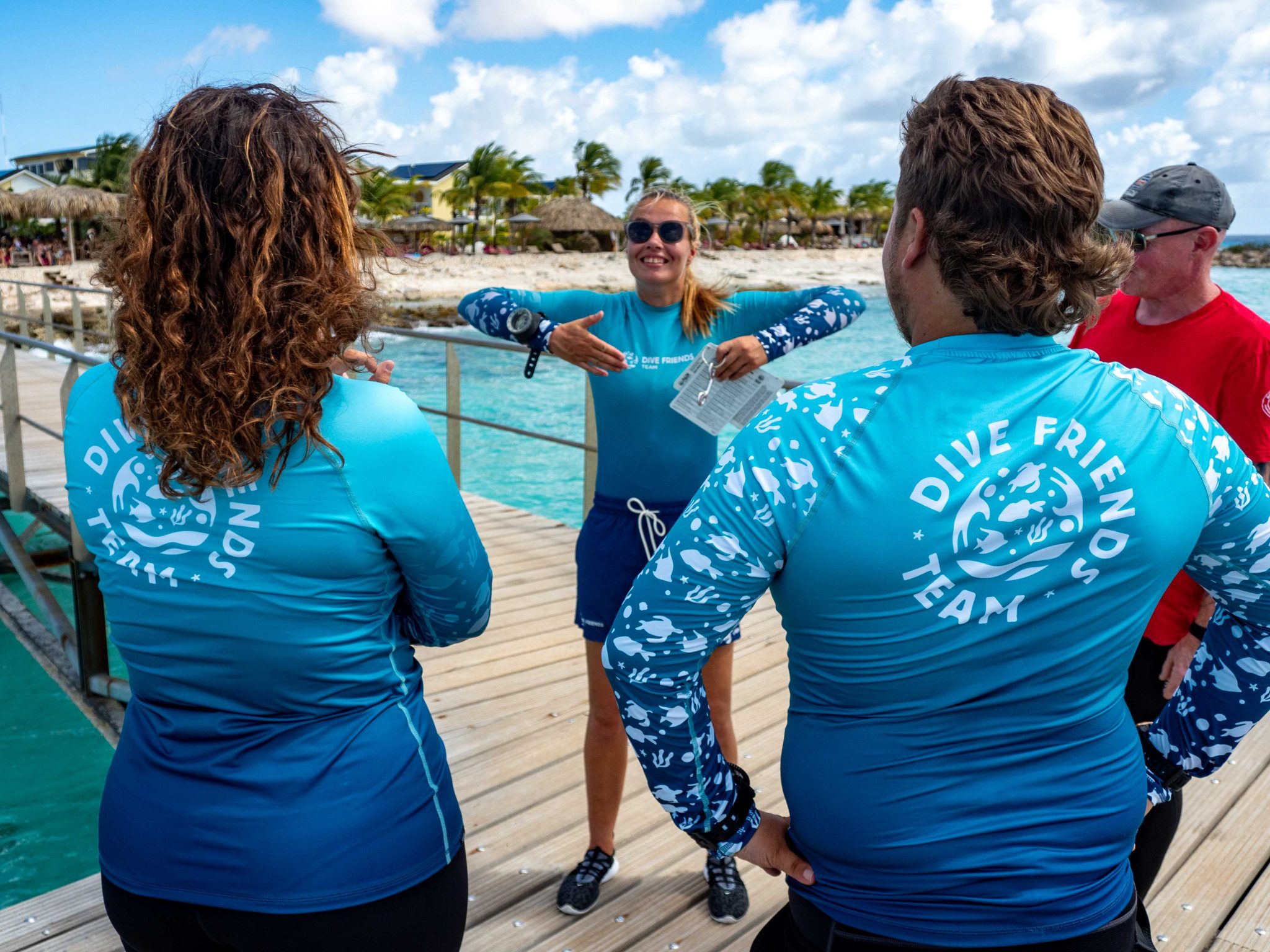
Dive Friends teaches the Instructor Development Course (IDC) several times a year to students who are eager to share their passion for diving with the world.
Dive Friends is known for the personal approach throughout the course. Their in-house course director will lead the students through every essential step, mentoring them to achieve their fullest potential as a dive instructor.
Applications for the following IDC start dates are now open:
- 12 April
- 5 July,
- 20 September
- 29 November
Partnership with Casita Palma
If the student opts for the IDC-Deluxe or IDC-Supreme package, their accommodation will be arranged for them at Casita Palma. This small and quiet resort is within walking distance from Dive Friends Bonaire’s main dive shop location and has everything you need to relax after an intense day of IDC training. Breakfast is included, so the student will always be fuelled and ready for their day.
Contact Dive Friends Bonaire’s Course Director Eddy for more information: coursedirector@divefriendsbonaire.com.
-

 News3 months ago
News3 months agoHone your underwater photography skills with Alphamarine Photography at Red Sea Diving Safari in March
-

 News2 months ago
News2 months agoCapturing Critters in Lembeh Underwater Photography Workshop 2024: Event Roundup
-

 Marine Life & Conservation Blogs2 months ago
Marine Life & Conservation Blogs2 months agoCreature Feature: Swell Sharks
-

 Blogs2 months ago
Blogs2 months agoMurex Resorts: Passport to Paradise!
-

 Blogs2 months ago
Blogs2 months agoDiver Discovering Whale Skeletons Beneath Ice Judged World’s Best Underwater Photograph
-

 Gear News3 months ago
Gear News3 months agoBare X-Mission Drysuit: Ideal for Both Technical and Recreational Divers
-

 Gear Reviews2 months ago
Gear Reviews2 months agoGear Review: Oceanic+ Dive Housing for iPhone
-

 Marine Life & Conservation2 months ago
Marine Life & Conservation2 months agoSave the Manatee Club launches brand new webcams at Silver Springs State Park, Florida















